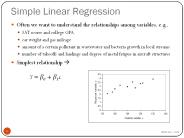Relation between photoluminescence and photoluminescence-excitation spectra in the linear response regime measured on two-dimensional electron gas - PowerPoint PPT Presentation
Title:
Relation between photoluminescence and photoluminescence-excitation spectra in the linear response regime measured on two-dimensional electron gas
Description:
07 7/27 memo Relation between photoluminescence and photoluminescence-excitation spectra in the linear response regime measured on two-dimensional electron gas – PowerPoint PPT presentation
Number of Views:610
Avg rating:3.0/5.0
Title: Relation between photoluminescence and photoluminescence-excitation spectra in the linear response regime measured on two-dimensional electron gas
1
Relation between photoluminescence and
photoluminescence-excitation spectra in the
linear response regime measured on
two-dimensional electron gas
07 7/27 memo
- T. Ihara, Akiyama group, ISSP
Abstract
Photoluminescence (PL) and photoluminescence-excit
ation (PLE) spectra of two-dimensional electron
gas are measured in the linear response regime.
We found the ratio between PL and PLE is
proportional to exp(-hv/kT), where T agrees with
lattice temperature. This is the first
verification of the general relation between
emission and absorption in the linear response
regime, or Kubo-Martine-Schwinger relation, which
is exact under quasi-equilibrium condition.
2
Introduction
In photoluminescence-excitation (PLE)
measurements,the intensity of photoluminescence
(PL) isrecorded as a function of excitation
photon energy. Under a condition of fast
intra-band relaxation, PLE is equivalent to
linear absorption spectra 1, 2. Using micro-PL
technique, we can compare the lineshape of PLE
with PLat the same microscopic region of 1mm
order. The relation between PL and PLE in the
linear response regime is the focus of this paper.
1 Fundamentals of Semiconductors 3rd Edition,
Yu-Cardona (2001)In high quality GaAs QWs, the
scattering processes with LO photon and acoustic
phonon occur on picosecond and subpicosecond time
scales, which are significantly shorter than the
radiative lifetime.Thus, one finds a good
correspondence between the PLE and absorption
spectra. 2 K. Hannewald et al., Phys. Rev. B
67, 233202 (2003).The supposed equivalence
between PLE and absorption signals in
semiconductors relies on the assumption that the
recombination times are much larger than the
intra-band relaxation times, I.e., if the
laser-excited electrons and holes have enough
time to relax completely into quasi-equilibrium
before radiative recombination.
3
Introduction
According to early theories 3, the relation
between emission (I) and absorption (A) of
quasi-equilibrium systems in semiconductors could
be written in a simple form
- ?
where hv is photon energy, m is chemical
potential, T is temperature. This is known as
Kubo-Martine-Schwinger relation, which has been
investigated experimentally by time-resolved
spectroscopy 4.Under low-excitation power
condition, this relation becomes simpler since
exponential part becomes larger than 1
- ?
This relation is same form as Kennerd-Stepanov
relation, which has been indicated by D. A.
Sawicki et al. 5 as a general relation between
emission and absorption of a system in thermal
equilibrium. There are two required conditions
for these relations Linear response and
Quasi-equilibrium. There have been no
experiments that achieved the verification of
relation ? under proper conditions.
3 H. Haug et al., Prog. Quantum Electron. 9, 3
(1984). 4 S. Chatterjee, C. Ell, S. Mosor, G.
Khitrova, and H. M. Gibbs, W. Hoyer, M. Kira, S.
W. Koch, J. P. Prineas, and H. Stolz, Phys. Rev.
Lett. 92, 067402 (2004). 5 D. A. Sawicki and
R. S. Knox, Phys. Rev. A 54, 4837 (1996).
4
In this letter
In this letter, we study the relation between PL
and PLE spectra of two-dimensional electron gas
in the linear response regime.We found the
ratio between PL and PLE is proportional to
exp(-hv/kT), where T agrees with lattice
temperature.This is the first verification of
the general relation between emission and
absorption in the linear response regime, or
Kubo-Martine-Schwinger relation, which is exact
under quasi-equilibrium condition.
PL independent on Pex -gt emission in linear
response regime PL independent on Eex -gt Fast
intraband relaxation. PLE independent on Pex
-gt absorption in linear response regime PL/PLE
exp(-hv/kT) -gt no exception in whole photon
energy region TTL -gt Quasi-Equilibrium at
TL TTL at any TL -gt no exception in
temperature ? we achieved the verification of
I/A exp(-hv/kT)
5
Optical setup and sample structure
PL and PLE measurement in a backscattering
geometry. Detect PL polarized with perpendicular
to the polarization of excitation laser 2DEG
density ( VDP measurement) 61010 cm-2
6
Power/Energy dependence of PL spectra at 30K
Lineshape of PL are independent with excitation
power at Pex lt 80 mW. -gt PL in the linear
response regime Lineshape of PL are independent
with excitation photon energy at Pex 1.7 mW.
-gt fast intra-band relaxation
7
Power dependence of PLE spectra at 30K
Lineshape of PL and PLE are independent with
excitation power at Pex lt 80 mW. -gt PLE in the
linear response regime Fast relaxation -gt PLE
is equivalent to linear absorption spectra
8
Ratio of PL and PLE at Pex 1.7mW (T 30K)
PL/PLE shows exponential decay against hv. No
exception in whole photon energy
region. Estimated temperature (T 302 K)
agrees with the lattice temperature (TL
30.81K) -gt Photo-excited 2DEG is in
quasi-equilibrium at lattice temperature.
9
PL/PLE at various temperatures (Pex 16 mW )
T agree with TL at various temperature.
-gt verification of general relation between PL
and PLE in the linear response regime for
quasi-equilibrium system
10
PL with resonant/non-resonant excitation at 5K
(Pex 2 mW)
In the case of resonant excitation, T ( 6.20.3
K) agrees with TL ( 5.61 K). In the case of
non-resonant excitation ( 6.3 meV), T (
7.20.5 K) is higher than TL ( 5.61 K) and
additional non-equilibrium component appears at
higher energy side (ML fluctuation).
11
Summary
Photoluminescence and photoluminescence-excitation
spectra of two-dimensional electron gas are
measured at low-excitation power in the linear
response regime. We found that the ratio between
PL and PLE is proportional to exp(-hv/kT), where
T agrees with lattice temperature, even at 6K
under resonant-excitation. This is the first
verification of the general relation between
emission and absorption in the linear response
regime, or Kubo-Martine-Schwinger relation, which
is exact under quasi-equilibrium condition.
?? Discussion?????
?????????CW?????QW???? ??????
Knox?chatterjee??????????????
???????????????????????? ???????????????????????
????? ??????KMS???? ????????????????????
???????????????????????































